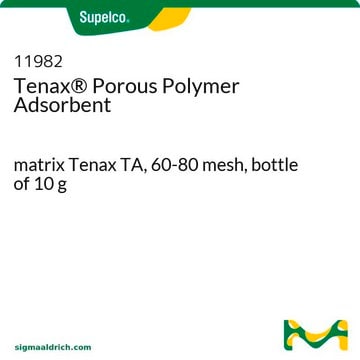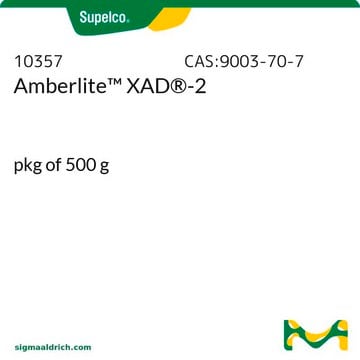21705-U
Carbotrap® 300 Thermal Desorption Tube
stainless steel, O.D. x I.D. x L 1/4 in. × 3 1/2 in., preconditioned, pkg of 10 ea
Synonym(s):
Carbon adsorbent, TD Tube
About This Item
Recommended Products
product name
Carbotrap® 300, O.D. × L 1/4 in. × 3 1/2 in., stainless steel TD tube, preconditioned, pkg of 10 ea
material
stainless steel TD tube
Agency
EPA TO-1,TO-2,TO-3,TO-17
description
Sealed with TDS³ Storage Container
product line
Carbotrap®
feature
preconditioned
packaging
pkg of 10 ea
greener alternative product characteristics
Waste Prevention
Safer Solvents and Auxiliaries
Learn more about the Principles of Green Chemistry.
sustainability
Greener Alternative Product
technique(s)
active air sampling: suitable
O.D. × L
1/4 in. × 3 1/2 in.
matrix
Carbosieve S-III carbon molecular sieve (CMS)
Carbotrap® 300 (Packed with Carbotrap C, Carbotrap B, Carbosieve SIII)
Carbotrap® B graphitized carbon black (GCB)
Carbotrap® C graphitized carbon black (GCB)
application(s)
air monitoring
environmental
industrial hygiene
compatibility
for use with DANI, Markes, OI Analytical, PerkinElmer and Shimadzu Instruments
Looking for similar products? Visit Product Comparison Guide
Related Categories
General description
Application
- Using mesoporous silica MCM-41 for in-line enrichment of atmospheric volatile organic compounds: This study demonstrates the utilization of mesoporous silica MCM-41, similar to Carbotrap® 300, for trapping and analyzing atmospheric volatile organic compounds, highlighting the material′s effectiveness in environmental sampling solutions (Wu et al., 2006).
Legal Information
Storage Class Code
13 - Non Combustible Solids
WGK
nwg
Flash Point(F)
Not applicable
Flash Point(C)
Not applicable
Choose from one of the most recent versions:
Certificates of Analysis (COA)
Sorry, we don't have COAs for this product available online at this time.
If you need assistance, please contact Customer Support.
Already Own This Product?
Find documentation for the products that you have recently purchased in the Document Library.
Our team of scientists has experience in all areas of research including Life Science, Material Science, Chemical Synthesis, Chromatography, Analytical and many others.
Contact Technical Service






